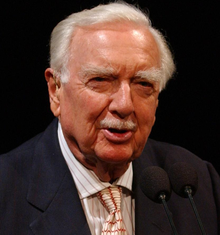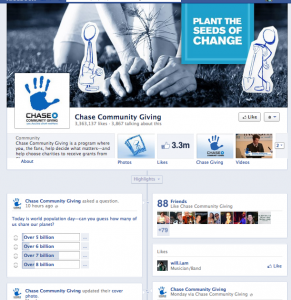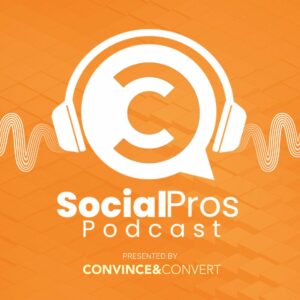Hosted By
About Social Pros Podcast:
Social Pros is one of the longest-running marketing podcasts in existence (10 YEARS and counting), and was recently recognized as the #1 Audio/Podcast Series by the Content Marketing Awards.
Our purpose? Making sure that we speak to real people doing real work in social media.
Listeners get inside stories and behind-the-scenes secrets about how teams at companies like Google, Reddit, Glossier, Zillow, Lyft, Marvel, and dozens more, staff, operate, and measure their social media programs. With 600+ episodes, the Social Pros Podcast brings the humanity of social media to the forefront, while providing incredibly useful marketing strategies that listeners can immediately implement.
Follow Social Pros on LinkedIn.
To inquire about becoming a guest or show sponsor, please email our Executive Producer, Leanna Pham, at leanna@convinceandconvert.com.
Apple Podcast Reviews:
The Social Pros podcast has quickly become a favorite in my feed! I'm consistently impressed by the engaging conversations, insightful content, and actionable ideas. I truly learn something every time I listen!
@Arlie KThis is absolutely an awesome listen for anyone in communications or social media!!
@Will31CThis podcast has become one of my staple weekly podcasts for learning about marketing! Love the conversations that they have and it's always enjoyable and educational!
@Simonstone95Love the podcast - informative, in depth and spot on for any business size.
@MissTriathlon
This is Episode 24 of the Social Pros Podcast : Real People Doing Real Work in Social Media. This episode features Shawn Morton of JPMorgan Chase. Read on for insights from Shawn and Eric’s Social Media Stat of the Week (this week: are corporate crises isolated events or do they affect a brand for eternity?). Listen Now […]
 This is Episode 24 of the Social Pros Podcast : Real People Doing Real Work in Social Media. This episode features Shawn Morton of JPMorgan Chase. Read on for insights from Shawn and Eric’s Social Media Stat of the Week (this week: are corporate crises isolated events or do they affect a brand for eternity?).
This is Episode 24 of the Social Pros Podcast : Real People Doing Real Work in Social Media. This episode features Shawn Morton of JPMorgan Chase. Read on for insights from Shawn and Eric’s Social Media Stat of the Week (this week: are corporate crises isolated events or do they affect a brand for eternity?).
Listen Now
Click the play button to listen here:
[podcast]http://socialpros.podbean.com/mf/web/g66z7/SocialProsEpisode24.mp3[/podcast]
Download the audio file:
http://socialpros.podbean.com/mf/web/g66z7/SocialProsEpisode24.mp3
The RSS feed is: http://feeds.feedburner.com/socialprospodcast
Find us on iTunes: http://itunes.apple.com/us/podcast/convince-convert-blog-social/id499844469
Please Support Our Sponsors
Huge thanks to data-driven social media management software company Argyle Social for their presenting sponsorship, as well as Infusionsoft, Janrain, and Jim Kukral at DigitalBookLaunch. We use Argyle Social for our social engagement; we use Infusionsoft for our email; Janrain is our crackerjack social integration company, and Jim is our guest host for the podcast (and a smart guy).
Social Pros Transcript For Your Reading Enjoyment, Thanks to Speechpad for the Transcription
![]()
Jay: Welcome everybody to Social Pros, episode number 24, otherwise known as the Kobe Bryant episode. I am Jay Baer, back from a relaxing Mediterranean vacation. Joined as always by Eric Boggs, who is stuck in the United States of America.
Eric: You know, Jay, I was going to say that episode number 24 should be the Eric Boggs in high school episode, not necessarily the Kobe Bryant episode.
Jay: You were rocking 24? That was your digits when you were on the mean streets in high school?
Eric: Yeah, man. That’s hanging from the rafters North Gaston High School. But not really.
Jay: I was going to say, they’re retiring high school numbers at North Gaston? That is impressive. You were in the ring of honor. We’ve got a great guest today, in my triumphant return to Social Pros. We have a great guest, Shawn Morton, who is the Vice President of Social Media at JP Morgan Chase. He’s one of the 1%-ers. It’s going to be awesome to have him on the show. Obviously big time global financial services players at the JP Morgan Chase Co., so lots of issues to talk to him about. It’s going to be very exciting.
Eric: Indeed.
Jay: As always, want to thank our sponsors of the show, Eric’s company, data driven, results focused, social media management company Argyle Social. Our friends at Infusionsoft, our buddies at Janrain, social sign-in and all kinds of mapping social media to databases, amazing company doing crazy stuff. And our friend Jim Kukral at digitalbooklaunch.com, who pitch hits when I am away. Thanks for holding down the fort while I was gone by the way, chief.
Eric: Yeah, I was going to say, shout out to Jim. He and I had a couple of good conversations with DJ Waldow and Evan Hamilton while you were away.
Jay: Awesome. Thank you very much. I’m actually going to be out next week too, so you can do it all over again.
Eric: Jay, I’m having to do too much work for this.
Jay: I know. This is supposed to be my baby. It’s gotten a little out of control for you, I apologize. I’m doing my best, I really am.
Eric: I know, I know, I’m teasing. This is great.
Jay’s Thought of the Week
Jay: I know. Let’s talk about what’s going on in social media. I don’t think you talked about this last week, and if you did, stop me now. What I want to talk about, in terms of my issue of the week is the report from our friend Jeff Widman last week about the diminishment in people using Facebook tabs. The stat is that, according to pagelever.com, Jeff Widman’s company, I’m an investor in the company, full disclosure, that since Timeline rolled out, there’s a 53% decline in impressions on Facebook tabs. Which probably isn’t a huge surprise mathematically, because you can’t now set a custom landing tab that forces people to look at your tabs. The tabs are hidden on the right underneath the big profile image. They don’t have as much visual impact on the page, etc. But 53% is a lot.
I think what we are finding now is Facebook is even more similar to email than it was before. You and I have talked a lot, that Facebook is strategically and mechanically similar to email, but I think even more so now, if you can’t really rely on a lot of tab usage; in terms of filling out forms or entering a contest or doing whatever else you might do on a tab. If it’s really just the Wall, if it’s really just the news feed, all it is is a day to day, keep you top of mind experience, which to me is email. There was a time when Facebook was starting to much more operate like a micro-site. In fact, I wrote a blog post probably 18 months or so on Convince & Convert, about hey, Facebook is going to kill your website. That you won’t need a website, because everything you can do on your website you can do on Facebook. Now it seems like it’s going absolutely the other direction.
Eric: Yeah, I felt like this has been a long time coming. I don’t know if I left a comment on the blog post that you wrote 18 months ago, but I probably would have disagreed with you. I don’t know that Facebook ever wanted to be a business’s website. I think that Facebook wants to be embedded on every website in the Internet. I think their vision is actually much bigger and much more evil than replace your website.
Jay: Oh, I agree. My assertion was not that that was their plan, but that was what was happening.
Eric: Yeah. The whole tab thing obviously hits close to home for Argyle. Our customers inquire with us about Facebook tabs from time to time. We actually partner with a company called North Social that does Facebook tabs.
Jay: I’ve used those guys as well. They actually built the Facebook page for the Now Revolution book Facebook.
Eric: Yeah, they’re really good dudes. Fun fact, their CEO was a professional football player for a number of years.
Jay: He also has his number retired at North Gaston High School.
Eric: Yeah, Alex did not go to North Gaston. I don’t know where he went to school, but I imagine that he is also in the ring of honor.
Jay: His number might actually be.
Eric: Anyway, back to this stat from Jeff. At Argyle, we’ve always been like, we don’t think the tabs matter much. It’s all about what’s in the stream. It’s funny, because we’ve often cited research from Jeff at PageLever, because they’re the ones that every six months or so, they pipe up with hey, the way you think your customers use Facebook isn’t exactly the way they use Facebook. There tends to be a recurring theme of hey, it’s all about the feed, it’s all about the feed, it’s all about the feed. I think that Facebook’s migration to Timeline reflects that, and I think the data that Jeff and David and his team have churned up, also reflects that. It is about real timeliness and curating content in a feed.
Jay: One of the things I don’t see companies doing to counteract that, however, is creating status updates in the feed that link to the tabs. To me, that’s the way you solve that problem. You treat a tab as a landing page, it’s a landing page that exists within the Facebook ecosystem. I just don’t see that happening very much, and I don’t get it.
Eric: I’ll tell you, it’s a mixed bag, right? Companies have a process, and they have capabilities to get things uploaded on their website. Getting stuff done on Facebook is a completely different animal. I think a lot of it is just a resources, capabilities question. I’ll tell you, if you could do social sign-in either on your site, or somehow getting social credentials on platform at Facebook, that’s the big opportunity. To cut to the chase, you want to be able to cookie people.
Jay: That’s why Janrain is so interesting, the stuff they’re working on and the stuff they do now.
Eric: Exactly. You can cookie people either by dumping them on your website where you can drop a cookie, passing them through a URL redirection where you can drop a cookie, or through a social sign-in. I think ultimately that will be the objective, as marketers get savvier and smarter about social marketing, and taking a cross-channel view. I’m kind of glad that Facebook tabs are becoming less of an issue, because it means that people have to think more strategically and it’s less about, “hey, let’s just put up an email sign up form, and that’s our social strategy”. I think people are going to have to be a little smarter about how they leverage the tools going forward.
Jay: It certainly makes it a little less direct response oriented. It was getting a little Yellow Pages-y there for a while.
Eric: Yeah, yeah. You go to a site and it’s like, “don’t forget to Like us to download the white paper.” It’s like oh guys, come on, this is just obnoxious.
Jay: Exactly. Do you have a social media stat of the week?
Eric’s Social Media Stat of the Week:
Eric: I do. The triumphant return of Jay, brings about the triumphant return of the social media stat of the week. While you were out, Jay, I have to admit I didn’t prepare a stat of the week, simply because I was too busy.
Jay: God, I go to Greece and the whole thing falls apart.
Eric: Yeah, we barely held it together, man. Duct tape and super glue.
Jay: Speaking of which, I’ve had this question from several people about gee, what was it like being in Greece? It was like being in Greece. This whole hey, the economy’s falling apart and people are living in caves, eating their young, it was unbelievable. Nothing has changed there. Everybody’s spending money, everybody’s eating. It was really a sharp, sharp contrast of what you read in the paper and what exists in the real world. It was amazing.
Eric: Well, yeah, the economic woes never seem to benefit the tourist, right? Those places are always going to be expensive, because that’s what they’ve got going for them.
Jay: No kidding. Sorry, I digress.

Eric: No problem. The stat of the week is, really not so much a stat of the week and I think maybe more of an anecdote of the week, with some numbers related to it. This is actually something that Jay sent to me via email. Susan G. Komen and Carnival Cruise Lines have both had some problems, over the past 12 months. You probably already know what those are, I won’t go into it. In 2011, Carnival, according to some brand reputation research from Harris Interactive, in 2011 Carnival was ranked the number two cruise line. In 2012, it doesn’t rank. In 2011, Susan G. Komen for the Cure was ranked number two overall, among a number of non-profit categories. In 2012, Susan G. Komen ranks 56th of 79 surveyed. Those are the stats. The story is that both of these companies had pretty big crises, and those crises spilled over into social media. There’s a linkage between the two, right? Are you yelling at your son in the background, Jay?
Jay: No, I was yelling at somebody else, sorry. I’m back now.
Eric: Corporate crises, right? They’re isolated events, or do they bleed on into eternity? It’s this great article by Ashlyn Brewer at standingpr.com. We’ll link it up in the transcript.
Jay: One of my clients, as a matter of fact.
Eric: StandingPR?
Jay: Yes.
Eric: Cool.
 Jay: It’s interesting, right? Because there’s always been this question about well, sure, Kenneth Cole said people are rioting in Egypt because they love their spring collection, and that was offensive. But that didn’t really affect their numbers, did it? It’s a snapshot in time, it’s the real time web. Every crisis only lasts for 20 minutes and then it blows over, etc. etc. I think this particular study gives some credence to the fact that if you really do stub your toe in social media in a big way that there is a persistent impact. Now, this particular report is very much correlation, not causation. Just because you’re not listed on some survey of the best cruise lines, does not mean you’re not making any money. You would have to do a lot more analysis there to put a dollar value on Carnival’s misstep, and obviously their misstep was not inherently social media oriented. It just became a thing because of social media. There’s a lot of different issues at play there. I do find it fascinating to think that maybe in this era where social media really has become the replacement for Walter Cronkite back in the day, that things have a longer shelf life than we who are on the inside anticipate.
Jay: It’s interesting, right? Because there’s always been this question about well, sure, Kenneth Cole said people are rioting in Egypt because they love their spring collection, and that was offensive. But that didn’t really affect their numbers, did it? It’s a snapshot in time, it’s the real time web. Every crisis only lasts for 20 minutes and then it blows over, etc. etc. I think this particular study gives some credence to the fact that if you really do stub your toe in social media in a big way that there is a persistent impact. Now, this particular report is very much correlation, not causation. Just because you’re not listed on some survey of the best cruise lines, does not mean you’re not making any money. You would have to do a lot more analysis there to put a dollar value on Carnival’s misstep, and obviously their misstep was not inherently social media oriented. It just became a thing because of social media. There’s a lot of different issues at play there. I do find it fascinating to think that maybe in this era where social media really has become the replacement for Walter Cronkite back in the day, that things have a longer shelf life than we who are on the inside anticipate.
Eric: Yeah. I think we talked about this several episodes back, about social media as offense versus social media as defense. Part of having a presence is all about mitigating negative word of mouth. An investment in a strong social framework, I don’t know the ins and outs of Carnival’s situation, but I do know that they banked a huge cruise ship in the Mediterranean a while back, right? An investment in social media probably would’ve been nice to have, when the Twitter firestorm erupted around that.
Jay: Yeah, no kidding. In fact, one of our friends was on that same cruise ship, not too long before the fateful scene.
Eric: Geez.
Jay: They were kind of freaking out.
Eric: That’s horrifying.
Jay: Indeed, indeed. Well, on that happy note, let’s bring in our special guest, Mr. Shawn Morton, who is the..
Eric: Horrifying.
Jay: The horrifying Vice President of Social Media at JPMorgan Chase, and one of the handsomest bald men that I’ve ever come across. Morty, thank you very much for taking the time to be on Social Pros.
Special Guest: Shawn Morton, JPMorgan Chase

Shawn: Thank you, and I appreciate you moving from that transition from horrible to complimenting me. That was very smooth.
Jay: It’s not my first rodeo.
Shawn: Exactly.
Eric: Jay’s a pro Shawn, and that just goes to show it.
Jay: Exactly. What’s new, man? How’s life in the big financial services world? What’s going on?
Shawn: It’s interesting. I think you made references to one of the challenges early, at the top of the show. With financial services, whether it’s at JPMorgan Chase or back when I was at Nationwide, it’s not a high interest category. Whether you have a crisis or you’re on the news every day or not, I think it’s just one of those things. People don’t necessarily think about their bank and think about their insurance company.
I think we’re always challenged with figuring out ways to engage customers in a meaningful way, and in a way that they need, rather than just trying to drive engagement for the sake of engagement. Which generally falls flat in a category like ours.
Jay: Would you say then that to Eric’s construct earlier, that you are engaging more in defensive social as opposed to offensive social?
 Shawn: I think we do a mix. I’ve been with the firm for about a year now, and when I came in, there still wasn’t a lot of social projects going on. I think our biggest one at the time and probably still our biggest now is Chase Community Giving, which is a philanthropy program we do with Facebook, we’ve got about three and a half million fans. We give away a few million dollars every year, by allowing folks to come in and nominate a charity, and then also come in and vote for which charities they feel are worthy. Our first step there was, I would say it was a safe step, cause marketing. We didn’t really go out on a limb there and try to do something too edgy.
Shawn: I think we do a mix. I’ve been with the firm for about a year now, and when I came in, there still wasn’t a lot of social projects going on. I think our biggest one at the time and probably still our biggest now is Chase Community Giving, which is a philanthropy program we do with Facebook, we’ve got about three and a half million fans. We give away a few million dollars every year, by allowing folks to come in and nominate a charity, and then also come in and vote for which charities they feel are worthy. Our first step there was, I would say it was a safe step, cause marketing. We didn’t really go out on a limb there and try to do something too edgy.
I think that initial move was trying to use the Facebook platform, trying to use it in a way that people connect with. Cause marketing is something that was pretty well proven at the time as a way to engage folks, a way that they’ll get involved for altruistic reasons, but also for that self-identifying with the charity. We started out there, but I think we’ve started to grow into doing customer support on Twitter and things that do get us into a little bit more of a defensive posture at time. For the most part we’ve always looked at it as where should we be to help our customers, or to add value? At least I haven’t it looked at as we need to be on the defensive here. It’s always been from a point of trying to add value into something.
Jay: It seems like social customer service would be a real challenge for a company of not just your size, but the number of touch points, the number of local branches you have, the number of local brokers you have, the number of everything you have, seems like the answer to most tweets would be, “Go to your branch.”
Shawn: Yeah. I think what’s interesting about, and I’m still learning a lot about it, is we have the call centers and support staff that we have. They’re experts on the various product lines and various areas. We have teams dedicated to things. I don’t answer the phone and go, “Hey, let me help you figure this out,” which would just be a bad thing. What they’ve done with the social media customer service piece, and it’s actually proudly housed right here in Columbus, Ohio, the team, they brought in folks from different lines of business. Whether it be retail or others, to actually staff this team, so that they probably can never cover every issue, but to try to have the breadth to be able to have folks that could attack a mortgage issue versus a retail banking issue. They try to resolve that without sending them to their branch or sending them to another channel.
Eric: How big is the team, Shawn?
Shawn: The team is, exact number I’m not sure, I think under a dozen. There’s ten to 12 folks that are focused on that full-time.
Eric: They report into a social media team, or they report to a customer service team?
Shawn: They actually end up reporting up through I believe the executive that’s responsible for servicing. The team is dedicated to the social space. Right now it’s Twitter only, but looking to figure out which channels to expand it to. Just started out at the beginning of this year, and so it’s @ChaseSupport on Twitter, if you want to check it out. It’s one of those things I think when I first came in, and we hired a lot of folks into the social team at the same time I was joining. That was that obvious gap that we had, compared to a lot of our competitors. I think just in the amount of time that we’ve been looking at it to get to the point where we are, I think everybody internally is pretty pleased. As you can imagine, any large company, whether regulated or not, it can be challenging to get a new program, to get people assigned to something, to be providing support in that way. I think everybody is realizing we can do more and expand, but we feel really good about where it is.
Jay: I was going to ask you that. How do new programs get approved? Is there a committee that you head up because you’re the vice president of social that says, “Yes, this is worthy of our time and attention,” and we have a center of excellence, we’re going to let people go hub and spoke, or what is the game plan for expanding social programs throughout the enterprise?
Shawn: I was going to say the way you described it would be one way, would be an interesting way. It’s a little more free form than that. One of my colleagues I think, explained it really well. He was talking about my time at Nationwide to my time here, and we were talking about the challenges. He said, “When you were at Nationwide, you were still pushing the boulder up the hill.” No one cared about social, so as long as you didn’t screw something up, you could pretty much try and do things and do whatever you want. Now you’ve pushed it, you’re at the point where it’s rolling down the hill, and it’s broken off into a thousand pieces, but those pieces are still big enough to hurt you. All these projects are coming down the mountain at you, and a lot of times you just have to duck and get out of the way.
I think that’s probably the best way I could think to describe it. Social has really exploded. Often projects start and we’re not the clearing house, so it’s not supposed to go to me and hey, if everything doesn’t get my stamp of approval, we’ve got dozen of folks that have got social media in their title and are responsible for social projects. It’s just the size of the organization I think. Often we’ll hear about things after they’re already out in market. Sometimes we hear about them early. I think what we’ve tried to do is really take more of an internal agency approach and say, “Look, this is what we do, this is what we’re good at, this is how we can help you,” and have people come to us. If people are calling you when they need help for social, I think you’re doing it the right way, versus trying to be heavy handed about it and say, “Everything’s got to come through me, and if I don’t like it you’re not allowed to do it.” We try to take that approach. Again, I’ve just been there barely a year, so I think it’s one of those things where, at an organization this size, it feels like people are just starting to figure out what I do versus some of my colleagues in the social space do.
Eric: Shawn, banks haven’t been on the top of people’s Christmas shopping lists, the past couple years. How does that factor into your day to day and what your team does?
Shawn: I think we’ve seen it. It’s one of those things I think everyone’s aware of, so even when you look at something like Chase Community Giving, which, this has the best intentions, there are folks that are going to look at that and go, “You’re just trying to whitewash over issues. Hey, here’s a couple million bucks here, and that’s going to make us forget about other things.” It’s always in the back of your mind I guess, no matter what we’re doing. Even if we say gosh, we’re about to announce open voting up for the next round of Chase Community Giving, but there’s always that discussion with the PR teams and everyone else to make sure that we’re alert.
What we found was that when people are upset with us, as I’m sure other brands find, they don’t necessarily stay on topic. You might say, “Hey, we just nominated this charity. They’re great, they’re helping children.” If someone’s got an issue and they see that come through their news feed, they’re going to jump in and tell you what they think, or ask a question. I think that was a cultural thing, but I think, sometimes naively, folks thought, “We’re not talking about the stuff that’s on the news, so we’re safe. We don’t have to worry about it that much.” I think we found out pretty quickly that sometimes we would wait to push messages.
Jay: You’re not setting the agenda, right? You’re not setting the script.
Shawn: Yeah, so sometimes we would hold off on a message, or we might just take a different approach, based on things that are going on externally from that program.
Eric: Sure.
Jay: You’ve been in digital marketing for a long time. 15 plus years, almost as long as I have. Eric’s been doing this a long time as well. You’ve seen several eras. You started in the web design business, back in the day. Do you think, and I’ve never asked anybody this ever, so we’ll see how this goes. Do you think, having been in digital as long as you have, is a net positive vis-a-vis your role in social, or a negative?
Shawn: I know since you’ve never asked anybody, this will be the best answer.
Jay: This will get the LinkedIn “best answers.”
Eric: For a while at least.
Shawn: Yeah, exactly. I would not ask anybody this question for a while because I’m struggling with this answer right now. I don’t know. I think sometimes a challenge with anybody that’s done something for a while is that I try to make sure that I don’t get, I don’t think jaded is the right word, but the, “Oh, I’ve tried that before.” I think that’s pretty easy to do in this space. Because I’m always trying to push the organization that way as well. When I say, “Hey, we should try this thing,” and they say, “Oh, we tried tactic X two years ago. Didn’t work.”
Often, as you know, it’s the way you approached it, it was something about the program, but people have written it off. I try to make sure that I don’t look at my experience in digital, going through dot com boom and bust, and have that cloud my enthusiasm for things. I think that’s where it can get dangerous is to go, “Well, we tried that,” or “Oh, that reminds me of something we did back when I was at CNET or at Nationwide,” or trying to at least stay focused. I think it could be a net negative I guess, if you always look to your experience and felt like well, because I did that before, whether successful or in failed projects, and using that to guide you, it could be a negative.
Jay: Good answer. Well done.
Eric: Best answer I’ve heard of that question.
Jay: I may have to ask that again sometime.
Shawn: I was feeling like it was getting there.
Eric: Jay, I know exactly where you’re headed with this. I think you and I talked about this at some point. There are two schools of social media performance. There’s the people that came out of the digital, online, more tech focused path, and there are those that come out of the PR, communications, journalism, type of path. I see that…
Jay: It’s math versus unicorns.
Eric: That’s one way of putting it, but I see that friction play out, every single day.
Jay: I’m sure you do, in the sales process in particular.
Eric: Yep.
Jay: You can’t sell math to unicorns, and you can’t sell unicorns to a math guy.
Eric: Indeed.
Jay: It’s a difficult situation. Shawn, you did some great stuff on the mobile side, when you were at Nationwide. The Nationwide mobile app in particular is one that I continue to use, even in presentations today, because I think it’s so inherently useful. Do you get involved on the mobile side at Chase at all? Or is that so far outside your purview that you’re an observer of it?
Shawn: A little bit. What’s interesting about the group that we’re in at Chase, is it’s actually all part of the same team. So, mobile, e-commerce and payments are also part of our group. It goes up through the same executive, so we do get to look at it. Often just the way social, when you look at things like Foursquare and other things, and even Facebook, mobile is such a big component of that, the lines are always blurry. A lot of the work we’re doing, and I won’t even say the acronym because it may be the acronym I hate the most.
Jay: Froyo?
Shawn: The one for social, I’m trying to remember what it is now.
Jay: SoLoMo?
Shawn: Yeah, that’s the one.
Jay: I thought you were going to say “froyo,” because that is my least favorite.
Shawn: OK, yeah. That’s up there. A lot of it ends up being that, because we do have such a strong mobile presence, the social team, and then with our physical branch network. Like you said before, 5,000 branches and 15,000 plus ATMs, there is that natural interplay between those channels. Yeah, it is something we are always, because even though we are social, I still think of us as trying to be the glue that brings a lot of the stuff together.

Jay: Where are you guys at now with the near field communications and I just wave my phone in the air and pay me kind of stuff?
Shawn: There’s a lot of stuff in the payment space. I think we’re looking at stuff, we’ve worked with lots of different companies in the payment space as well, in terms of looking at things all the time. It feels like one of those things that someone needs to come up with a standard or protocol and everybody gets on board.
I think we’re still in the phase where lots of different groups are trying to, it feels a little bit HD-DVD versus Blu-Ray. Except maybe there’s three or four more formats in this little payment space than there were there.
It still feels like we’re in that space where everybody’s going to try to have a mobile payment solution. I just don’t know that customers are going to go for it. I’ve got a new phone, it’s got Google Wallet on it, it’s got NMC, I don’t know how eager I’m going to be once I get used to using it, of switching apps or switching different ways of paying. I think it’ll be interesting, once users start to get there and play with it, I think hopefully we’ll see a little bit of standardization.
Jay: What I’ve seen so far is that everybody’s doing approximately the same thing. That’s the problem, right? There is no better mousetrap. If everybody has the exact same mousetrap, nobody’s going to win.
Somebody has to come up with something that’s inherently easier to use or better. Somebody needs to be the square of NFC. I’m sure that’s going to happen, it just hasn’t happened yet.
Mr. Morton, majestic bald man.
Eric: Horrifying bald man.
Jay: Yeah, horrifying majestic bald man, and answerer of the unanswerable question, do you have any Social Pros shoutouts for us?
Social Pros Shoutout
Shawn: I actually do. I have a couple, and they’re completely self-serving, which I’m sure shouldn’t surprise either of you. They’re a couple of my former colleagues from Nationwide that I feel are worth a shout out.
The first is Carolyn Kent, who is now the social strategist over at Express, which is based here in Columbus.
Jay: That Express the clothing gal?
Shawn: Yeah, they’re based here. She’s also the president of the social media club chapter here in Columbus. The reason why I wanted to give her a shout out is she has a strong point of view. A lot of times you’ll have folks that hear about a new development or new technology and everything’s great, like you said unicorns, and everything’s happy and rainbows.
I think what I like about Carolyn is she’ll give you her opinion, whether it’s something you’re going to like or not. Working together, that was often, it could be good or bad depending on which end of it you’re on. Now that we don’t work together it’s great. It’s wonderful, because everybody gets to experience it. I wanted to give her a shout out.
The other is a guy named Mike Houdeshell, who is actually still at Nationwide and is the man behind all of their social stuff, from content strategy to their link to customer service to the NASCAR sponsorship.
I always considered where I appreciated Carolyn’s strong point of view, Mike is one of those guys that’s the voice of reason. He’s been a professional writer and communicator for many, many years, and I think that’s what’s so great about having him on that team. He can sometimes take a situation and think through all the implications of what you’re going to communicate with that tweet and anticipate it. While everybody else is running around freaking out about the fact that someone tweeted something negative. Those are two folks that I would give a shout out to today.
Jay: Well done. Look at you working the Columbus mafia.
Shawn: Look at that, Cbus.
Jay: Tell you what, it’s something. We’ll be out there for Content Marketing World. Looking forward to it.
Shawn: Cool.
Jay: You’re going to that I presume, or will be?
Shawn: I’ll be around. Who knows. Just look for a horrible bald man.
Jay: Yes, we’ll know it’s you. Hopefully you’ll be there. I’ll probably be out there sooner than that for hockey. I’ll be out there a few times at least, so I will look you p.
Shawn: I think I’ve told you this, I live minutes from the Chiller North, so.
Jay: Perfect. We’ll be there. In fact my kids have hockey camp this week. I shipped them off. He’s at Kent, Ohio actually, not too far.
Shawn: OK.
Jay: Yeah. Eric, do you have any children in hockey? No, your kid’s one year old.
Eric: Yeah, no, I have a one year old. He just likes to bang things with sticks.
Shawn: That’s hockey.
Jay: Perfect. Yeah, exactly. You’re ready.
Eric: We’ll see. I anticipate there will be a drum set in my future.
Jay: Nice. Mr. Morton, thanks very much for joining us. Great episode, good shout outs, good stuff. Thanks again to Argyle Social, the presenting sponsor of Social Pros. Our friends at Infusionsoft, who we use for all of our email stuff. Janrain, social sign-in, social database, and our friend Jim Kukral at digitalbooklaunch.com, who’ll be back next week with Eric. Who’s on the show next week, Eric? Do you know yet?
Eric: Yeah, actually we’ve lined up Alison Carlman, she’s the community manager for Global Giving. Global Giving is a website that connects donors to doers, basically cultivate a list of non-profits and cause based organizations, and provide a very cool service to help people put the money to work in causes and places that they’re passionate about.
Jay: Great, love it. That’s episode number 25, so now you can get a discount on your car insurance.
Eric: Yeah, number 25, indeed.
Jay: Very good. I’m Jay, he’s Eric, this is Social Pros. Thanks as always for listening. Talk to you next week.







